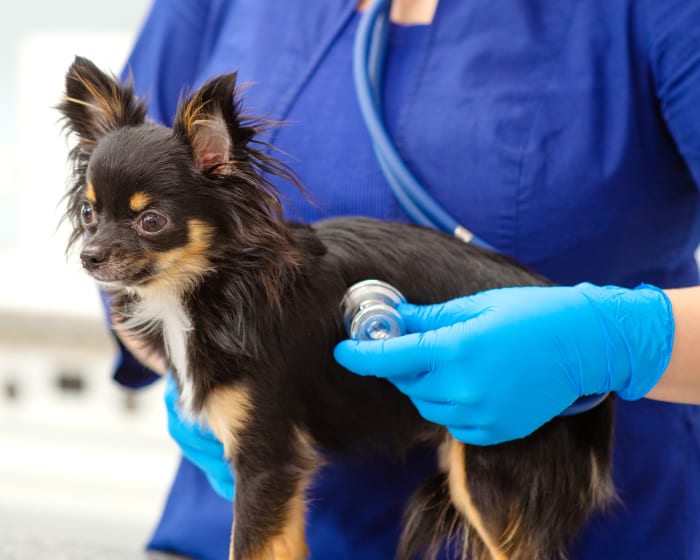What Pet Owners Should Know About CT Scans For Dogs}
Wiki Article
The Duty of Ultrasound and CT Scan in Modern Vet Practices: Insights From Experienced Professionals
In modern vet methods, ultrasound and CT scans substantially enhance diagnostic capacities. These imaging methods provide critical understandings into animal health, leading treatment choices. Experienced professionals acknowledge the distinct advantages of each modality. Ultrasound supplies real-time analyses, while CT scans deliver intricate physiological details. Comprehending their applications and roles raises important questions regarding their impact on client outcomes and the future of veterinary diagnostics. What insights can be gotten from their combined usage?Understanding Ultrasound in Vet Medicine
Ultrasound is a necessary diagnostic tool in veterinary medicine, supplying a non-invasive technique to imagine internal frameworks. This imaging method utilizes high-frequency acoustic waves to create real-time photos of body organs and tissues, permitting vets to evaluate conditions without surgical treatment. Usual applications include examining the heart, liver, kidneys, and reproductive organs, as well as keeping track of pregnancies.The treatment is fairly fast and can be carried out in various setups, making it an available choice for veterinarians. Unlike radiography, ultrasound provides in-depth info concerning soft cells and blood circulation, which is vital for accurate diagnoses.Veterinary specialists rely upon ultrasound to identify irregularities such as growths, cysts, and fluid buildup. Its ability to direct biopsies and other procedures additionally improves its energy in professional method. By using a risk-free and effective way to check out inner anatomy, ultrasound has ended up being a cornerstone of modern veterinary diagnostics.
The Advantages of CT Checks for Animal Diagnostics
CT scans offer significant advantages in vet diagnostics by offering enhanced accuracy in determining interior problems (Cancer Veterinary Near Me). As a non-invasive imaging method, they ensure the safety and security and comfort of pets during exams. On top of that, CT scans help with a comprehensive evaluation of interior frameworks, allowing for extra effective treatment preparationEnhanced Diagnostic Accuracy
Innovations in imaging modern technology have actually considerably improved analysis precision in veterinary medicine, particularly with using CT scans. These scans give detailed cross-sectional photos of an animal's interior frameworks, enabling veterinarians to determine irregularities with precision. The high resolution and three-dimensional capacities of CT imaging promote the discovery of problems such as tumors, cracks, and inner bleeding that could be missed with traditional imaging techniques. Additionally, CT scans can assist in pre-surgical preparation by using a comprehensive sight of physiological relationships. This degree of detail not only improves the precision of medical diagnoses however likewise aids in tailoring reliable treatment strategies. The assimilation of CT modern technology right into veterinary methods is changing the landscape of pet healthcare, enhancing results for individuals.Non-Invasive Imaging Strategy
The intro of non-invasive imaging strategies has reinvented animal diagnostics, with CT checks emerging as a famous device in vet practices. These scans give high-resolution, cross-sectional pictures of a pet's internal frameworks, permitting vets to examine complex conditions without the requirement for invasive procedures. The benefits of CT scans include their capacity to identify growths, fractures, and inner bleeding with exceptional precision. Furthermore, they facilitate the evaluation of soft tissues and organs, improving diagnostic capabilities. The speed of CT scanning makes it possible for quick decision-making, which is essential in emergency situation scenarios. By lessening stress and pain for the animal, CT scans add to an extra humane approach to diagnostics, eventually enhancing treatment end results and advancing veterinary care.Comprehensive Internal Analysis
A complete interior evaluation is vital for accurate diagnosis and effective treatment in vet medicine. CT checks offer considerable benefits in this respect, offering detailed cross-sectional pictures of an animal's interior frameworks. This advanced imaging method boosts visualization of intricate anatomical regions, making it possible for vets to recognize problems such as growths, fractures, and inner bleeding with higher precision. Furthermore, CT scans promote the analysis of conditions that may be challenging to identify through standard methods. The rate and accuracy of CT imaging additionally add to timely interventions, boosting client outcomes. As vet methods progressively integrate CT technology, the advantages of considerable interior analyses come to be apparent, strengthening the importance of this device in modern vet diagnostics.Comparing Ultrasound and CT Imaging Techniques
While both ultrasound and CT imaging offer essential functions in vet diagnostics, each method uses distinctive advantages and constraints that can influence clinical decision-making. Ultrasound is specifically valued for its real-time imaging capacities, enabling veterinarians to observe vibrant physical procedures. This technique is non-invasive, mobile, and does not involve ionizing radiation, making it a safer option for both clinicians and animals. Ultrasound may have constraints in imagining specific anatomical frameworks or deep tissues.Conversely, CT imaging supplies in-depth cross-sectional views of the body, allowing for exact localization of irregularities. It masters reviewing complex organs and frameworks, especially in the thorax and abdomen. Nonetheless, CT scans need sedation or anesthesia in a lot of cases and include exposure to ionizing radiation. Eventually, the option in between ultrasound and CT depends on the certain professional situation, the area of passion, and the necessity of the diagnostic requirements.Instance Studies: Successful Diagnoses With Imaging
Study show the significant improvements in diagnostic precision accomplished with innovative imaging innovations like ultrasound and CT scans in vet techniques. These advancements not only enhance the discovery of different problems however additionally promote effective and prompt therapy plans. Assessing specific instances can highlight the transformative impact of these imaging strategies on veterinary medication.Diagnostic Accuracy Improvements

Imaging Modern Technology Advancements
As veterinary imaging technology continues to develop, its impact on diagnostic capacities becomes progressively evident. Recent study highlight the effective application of sophisticated ultrasound and CT check methods in determining complex problems. A vet clinic utilized high-resolution CT scans to identify an unusual kind of lung cancer in a dog, which conventional imaging had actually missed. Likewise, an ultrasound exam exposed a stomach mass in a feline, prompting timely medical treatment and a favorable result. These improvements not just enhance analysis accuracy but also allow veterinarians to devise targeted therapy plans. By leveraging cutting-edge imaging modern technologies, veterinary professionals are considerably improving client care, resulting in more effective management of numerous health and wellness conditions in pets.
The Role of Imaging in Emergency Veterinary Treatment
Imaging plays a crucial role in emergency situation vet care, supplying vets with crucial details needed to make rapid, enlightened decisions. In urgent circumstances, methods like ultrasound and CT scans allow practitioners to quickly assess a pet's interior frameworks, identifying essential problems such as interior blood loss, cracks, or organ abnormalities. These imaging techniques enable for real-time assessments, facilitating timely treatments that can be life-saving. Ultrasound is vital for evaluating soft cells injuries and conditions like liquid buildup, while CT checks offer comprehensive pictures of complicated physiological structures, necessary for diagnosing injury instances. The rate and accuracy of these imaging techniques improve the vet's capacity to design effective treatment plans, guaranteeing the most effective feasible end results for their individuals. The integration of innovative imaging technologies right into emergency situation veterinary methods is not just beneficial yet significantly essential, as it boosts diagnostic capabilities and improves total animal care throughout essential moments.
Training and Know-how in Vet Imaging
Sophisticated imaging techniques such as ultrasound and CT scans are vital for effective veterinary care, the effective application of these technologies heavily depends on the training and experience of vet professionals. Competent use of imaging devices calls for complete knowledge of makeup, pathology, and the principles underlying each method. Veterinary specialists should undergo specialized training to properly analyze imaging outcomes, which is crucial for detecting problems and planning treatment.Certifications and continuing education and learning in veterinary imaging enhance the skills of professionals, allowing them to stay updated with technological developments. Partnership in between radiologists and vets often leads to improved analysis accuracy, as professionals can offer insights right into complicated situations. In addition, useful experience in dealing with imaging devices cultivates confidence in its application. Inevitably, the top quality of vet imaging services is directly associated to the level of training and competence possessed by the professionals making use of these essential diagnostic tools.Future Trends in Diagnostic Imaging for Animals
With the quick innovations in technology, veterinary diagnostic imaging is positioned for significant advancement in the coming years. Arising fads suggest a shift towards more available and portable imaging techniques, such as handheld ultrasound tools, which might improve area diagnostics. Additionally, the assimilation of synthetic intelligence is anticipated to change photo analysis, permitting quicker and more precise interpretations of results.Moreover, improvements in 3D imaging methods and computed tomography will give vets with more thorough views of animal anatomy, resulting in improved therapy plans. Online reality innovation might additionally play a function in surgical preparation and education, giving veterinarians a special viewpoint on complicated cases.As telemedicine remains to expand, remote assessments helped with by analysis imaging will certainly end up being much more typical, allowing specialists to assist basic experts in real-time. In general, these fads are readied to boost the effectiveness and performance of veterinary treatment, inevitably improving animal outcomes.Often Asked Concerns
Just How Much Do Ultrasound and CT Checks Cost in Veterinary Centers?
The expenses of ultrasound and CT scans in veterinary centers commonly range from $300 to $1,500, depending on elements such as location, center type, and particular procedures required for the pet's medical diagnosis and therapy.
Are There Any Type Of Dangers Connected With Ultrasound and CT Checks for Pet Dogs?
Ultrasound and CT scans usually posture minimal dangers to pets. Nevertheless, potential problems include sedation reactions and exposure to anesthetics. Cancer Veterinary Near Me. Vets thoroughly analyze each case to mitigate any risks connected with these diagnostic treatmentsFor How Long Do Ultrasound and CT Procedures Generally Take?
Ultrasound procedures normally take around thirty minutes to an hour, depending upon the intricacy. CT scans, being even more thorough, generally call for 30 minutes to 90 minutes, including prep work and recovery time for the pet dog.Can All Veterinarians Perform Ultrasounds and CT Scans?
Not all veterinarians can perform ultrasounds and CT scans. Specialized training and qualification are usually called for to guarantee competency in these advanced imaging techniques, which may restrict their schedule to veterinarians with extra credentials and sources.What Kinds Of Animals Benefit A Lot Of From These Imaging Techniques?
Specific pet types, specifically pet cats and dogs, advantage considerably from ultrasound and CT scans. These imaging techniques enhance diagnostic precision for conditions like growths, interior injuries, and body organ problems, resulting in improved therapy end results and client treatment. The high resolution and three-dimensional abilities of CT imaging help with the discovery of conditions such as tumors, fractures, and interior blood loss that could be missed Ultrasound For Dogs with typical imaging approaches. Situation research studies illustrate the significant renovations in diagnostic precision attained with innovative imaging technologies like ultrasound and CT scans in vet practices. Improving analysis precision in vet techniques has been considerably helped by improvements in imaging innovations such as ultrasound and CT scans. Innovative imaging methods such as ultrasound and CT scans are necessary for reliable vet treatment, the successful execution of these modern technologies heavily depends on the training and know-how of veterinary professionals. Vet experts must undertake specific training to properly translate imaging results, which is essential for identifying conditions and intending treatment.Certifications and proceeding education in veterinary imaging enhance the abilities of specialists, allowing them to stay upgraded with technical advancements.Report this wiki page